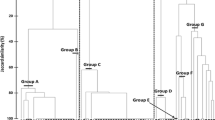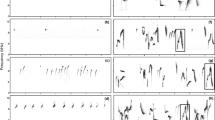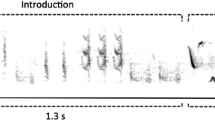Abstract
Repertoire size, the number of unique song or syllable types in the repertoire, is a widely used measure of song complexity in birds, but it is difficult to calculate this exactly in species with large repertoires. A new method of repertoire size estimation applies species richness estimation procedures from community ecology, but such capture-recapture approaches have not been much tested. Here, we establish standardized sampling schemes and estimation procedures using capture-recapture models for syllable repertoires from 18 bird species, and suggest how these may be used to tackle problems of repertoire estimation. Different models, with different assumptions regarding the heterogeneity of the use of syllable types, performed best for different species with different song organizations. For most species, models assuming heterogeneous probability of occurrence of syllables (so-called detection probability) were selected due to the presence of both rare and frequent syllables. Capture-recapture estimates of syllable repertoire size from our small sample did not differ significantly from previous estimates using larger samples of count data. However, the enumeration of syllables in 15 songs yielded significantly lower estimates than previous reports. Hence, heterogeneity in detection probability of syllables should be addressed when estimating repertoire size. This is neglected using simple enumeration procedures, but is taken into account when repertoire size is estimated by appropriate capture-recapture models adjusted for species-specific song organization characteristics. We suggest that such approaches, in combination with standardized sampling, should be applied in species with potentially large repertoire size. On the other hand, in species with small repertoire size and homogenous syllable usage, enumerations may be satisfactory. Although researchers often use repertoire size as a measure of song complexity, listeners to songs are unlikely to count entire repertoires and they may rely on other cues, such as syllable detection probability.



Similar content being viewed by others
References
Balsby TJS (2000) Song activity and variability in relation to male quality and female choice in whitethroats Sylvia communis. J Avian Biol 31:56–62
Balsby TJS, Dabelsteen T (2001) The meaning of song repertoire size and song length to male whitethroats Sylvia communis. Behav Proc 56:75–84
Bell BD, Pledger S (2002) Estimating the size of the complex song repertoire of the European marsh warbler Acrocephalus palustris using capture-recapture methods. Proc Int Ornithol Congr 23:165
Bell BD, Borowiec M, Lontkowski J, Pledger S (2004) Short records of marsh warbler (Acrocephalus palustris) song provide indices that correlate with nesting success. J Ornithol 145:8–15
Burnham KP, Overton WS (1978) Estimation of the size of closed population when capture probabilities vary among animals. Biometrika 65:625–633
Burnham KP, Overton WS (1979) Robust estimation of population size when capture probabilities vary among animals. Ecology 60:927–936
Burnham KP, Anderson DR, White GC, Brownie C, Pollock KH (1987) Design and analysis methods for fish survival experiments based on release-recapture. Am Fish Soc Monogr 5:1–437
Byers BE (1995) Song types, repertoires and song variability in a population of chestnut-sided warblers. Condor 97:390–401
Byers BE (1996) Geographic variation of song form within and among chestnut-sided warbler populations. Auk 113:288–299
Cam E, Nichols JD, Sauer JR, Hines JE (2002) On the estimation of species richness based on the accumulation of previously unrecorded species. Ecography 25:102-108
Catchpole CK, Slater PJB (1995) Bird song: biological themes and variations. Cambridge University Press, Cambridge
Chao A, Lee SM, Jeng SL (1992) Estimation of population size for capture-recapture data when capture probabilities vary by time and individual animal. Biometrics 48:201–216
Colwell RK, Coddington JA (1994) Estimating terrestrial biodiversity through extrapolation. Philos Trans R Soc Lond B 345:101–118
Darroch JN (1958) The multiple-recapture census. I. Estimation of a closed population. Biometrika 45:343–359
Eens M (1997) Understanding the complex song of the European starling: an integrated ethological approach. Adv Study Behav 26:355–434
Eens M, Pinxten R, Verheyen RF (1991) Male song as a cue for mate choice in the European starling. Behaviour 116:210–238
Espmark YO, Lampe HM, Bjerke TK (1989) Song conformity and continuity in song dialects of redwings Turdus iliacus and some ecological correlates. Ornis Scand 20:1–12
Forstmeier W, Balsby TJS (2002) Why mated dusky warblers sing so much: territory guarding and male quality announcement. Behaviour 139:89–111
Forstmeier W, Kempenaers B, Meyer A, Leisler B (2002) A novel song parameter correlates with extra-pair paternity and reflects male longevity. Proc R Soc Lond B 269:1479–1485
Galeotti P, Saino N, Sacchi R, Møller AP (1997) Song correlates with social context, testosterone and body condition in male barn swallows. Anim Behav 53:687–700
Galeotti P, Saino N, Perani E, Sacchi R, Møller AP (2001) Age-related song variation in male barn swallows. It J Zool 68:305–310
Garamszegi LZ, Boulinier T, Møller AP, Török J, Michl G, Nichols JD (2002a) The estimation of size and change in composition of avian song repertoires. Anim Behav 63:623–630
Garamszegi LZ, Doutrelant C, Lampe HM, Boulinier T (2002b) ISBE round table report: a new method to estimate repertoire size. ISBE Newsletter 14:23–24
Garamszegi LZ, Møller AP, Erritzøe J (2003) The evolution of immune defense and song complexity in birds. Evolution 57:905–912
Garamszegi LZ, Møller AP, Török J, Michl G, Péczely P, Richard M (2004) Immune challenge mediates vocal communication in a passerine bird: an experiment. Behav Ecol 15:148–157
Gil D, Gahr M (2002) The honesty of bird song: multiple constraints for multiple traits. Trends Ecol Evol 17:133–141
Gil D, Slater PJB (2000a) Multiple song repertoire characteristics in the willow warbler (Phylloscopus trochilus) correlations with female choice and offspring viability. Behav Ecol Sociobiol 47:319–326
Gil D, Slater PJB (2000b) Song organisation and singing patterns of the willow warbler, Phylloscopus trochillus. Behaviour 137:759–782
Gil D, Cobb JLS, Slater PJB (2001) Song characteristics are age dependent in the willow warbler, Phylloscopus trochilus. Anim Behav 62:689–694
Gorissen L, Janssens E, Pinxten R, Eens M (2002) Differences in song repertoire size and composition between two populations of blue tits Parus caeruleus. Avian Sci 2:39–47
Greenacre MJ (1993) Correspondence analysis in practice. Academic Press, London
Hansen P (1984) Neighbor-stranger song discrimination in territorial yellowhammer Emberiza citrinella males, and comparison with responses to own and alien song dialects. Ornis Scand 15:240–247
Hartshorne C (1956) The monotony-threshold in singing birds. Auk 83:176–192
Hartshorne C (1973) Born to sing. an interpretation and world survey of bird song. Indiana University Press, Bloomington
Hiebert SM, Stoddard PK, Arcese P (1989) Repertoire size, territory acquisition and reproductive success in the song sparrow. Anim Behav 37:266–273
Horn AG, Falls JB (1996) Categorisation and the design of signals: the case of song repertoires. In: Miller EH (ed) Ecology and evolution of acoustic communication in birds. Cornell University Press, Ithaca, N.Y., pp 121–136
Horning CL, Beecher MD, Stoddard PK, Cambell SE (1996) Song perception in the song sparrow: importance of different parts of the song in song type classification. Ethology 94:46–58
Jones AE, Cate Ct, Bijleveld CCJH (2001) The interobserver reliability of scoring sonagrams by eye: a study on methods, illustrated on zebra finch songs. Anim Behav 62:791–801
Krebs JR, Kroodsma DE (1980) Repertoires and geographical variation in birdsong. Adv Study Behav 11:143–177
Kroodsma DE (1982) Song repertoires: problems in their definition and use. In: Kroodsma DE, Miller EH (eds) Acoustic communication in birds. Academic Press, New York, pp 125–146
Kroodsma DE, Parker LD (1977) Vocal virtuosity in brown thrasher. Auk 94:783–785
Lampe HM, Espmark YO (1987) Singing activity and song pattern of the redwing Turdus iliacus during the breeding season. Ornis Scand 18:179–185
Lampe HM, Espmark YO (1994) Song structure reflects male quality in pied flycatchers, Ficedula hypoleuca. Anim Behav 47:869–876
Lebreton J-D, Burnham KP, Clobert J, Anderson DR (1992) Modeling survival and testing biological hypotheses using marked animals: a unified approach with case studies. Ecol Monogr 62:67–118
Lee SM, Chao A (1994) Estimating population size via sample coverage for closed capture-recapture models. Biometrics 50:88–97
Leitner S, Voigt C, Gahr M (2001) Seasonal changes in the song pattern of the non-domesticated island canary (Serinus canaria), a field study. Behaviour 138:885–904
Lessells CM, Boag PT (1987) Unrepeatable repeatabilities: a common mistake. Auk 104:116–121
Nemeth E (1996) Different singing styles in mated and unmated reed buntings Emberiza schoeniclus. Ibis 138:172–176
Nichols JD, Conroy MJ (1996) Estimation of species richness. In: Wilson DE, Cole FR, Nichols JD, Rudran R, Foster MS (eds) Measuring and monitoring biological diversity: standard methods for mammals. Smithsonian Institution Press, Washington D.C., pp 227–234
Nichols JD, Boulinier T, Hines JE, Pollock KH, Sauer JR (1998) Inference methods for spatial variation in species richness and community composition when not all species are detected. Conserv Biol 12:1390–1398
Norris JL, Pollock KH (1995) A capture-recapture model with heterogeneity and behavioural response. Environ Ecol Stat 2:305–313
Norris JL, Pollock KH (1996) Non-parametric MLE under two closed capture-recapture models with heterogeneity. Biometrics 52:639–649
Otis DL, Burnham KP, White GC, Anderson DR (1978) Statistical inference from capture data on closed animal populations. Wildl Monogr 62:1–135
Pledger S (2000) Unified maximum likelihood estimates for closed capture-recapture models using mixtures. Biometrics 56:434–442
Pollock KH, Otto MC (1983) Robust estimation of population size in closed animal populations from capture recapture experiments. Biometrics 39:1035–1049
Pollock KH, Nichols JD, Brownie C, Hines JE (1990) Statistical inference for capture-recapture experiments. Wildl Monogr 107:1–97
Rexstad E, Burnham KP (1991) User’s guide for interactive program CAPTURE. Abundance estimation of closed animal population. Colorado State University, Fort Collins, Co, USA
Riebel K, Slater PJB (1999) Song type switching in the chaffinch, Fringilla coelebs: timing or counting? Anim Behav 57:655–661
Riebel K, Slater PJB (2000) Testing the flexibility of song type bout duration in the chaffinch, Fringilla coelebs. Anim Behav 59:1135–1142
Rocha EPC, Danchin A, Viari A (1999a) Analysis of long repeats in bacterial genomes reveals alternative evolutionary mechanisms in Bacillus subtilis and other competent prokaryotes. Mol Biol Evol 16:1219–1230
Rocha EPC, Danchin A, Viari A (1999b) Functional and evolutionary roles of long repeats in prokaryotes. Res Microbiol 150:725–733
Saino N, Galeotti P, Sacchi R, Møller AP (1997) Song and immunological conditions in male barn swallows (Hirundo rustica). Behav Ecol 8:364–371
Searcy W, Nowicki S, Peters S (1999) Song types as fundamental units in vocal repertoires. Anim Behav 58:37–44
Slater PJB (1981) Chaffinch song repertoires—observations, experiments and discussion of their significance. Z Tierpsychol 56:1–24
Titus RC (1998) Short-range and long-range songs: Use of two acoustically distinct song classes by dark-eyed juncos. Auk 115:386–393
Titus RC, Ketterson ED, Nolan V (1997) High testosterone prior to song crystallization inhibits singing behavior in captive yearling dark-eyed juncos (Junco hyemalis). Horm Behav 32:133–140
Van Duyse E, Pinxten R, Eens M (2002) Effects of testosterone on song, aggression, and nestling feeding behavior in male great tits, Parus major. Horm Behav 41:178–186
Wildenthal JL (1965) Structure in primary song of the mockingbird (Mimus polyglottos). Auk 82:161–189
Williams BK, Nichols JD, Conroy MJ (2002) Analysis and management of animal populations. Academic Press, New York
Acknowledgements
The authors are highly indebted to all the colleagues, students and assistants who participated in the song recordings and analyses. We are very grateful to J. Nichols, S. Pledger, K. Riebel and P.J.B. Slater for their useful comments. K. Riebel kindly provided data on the chaffinch.
Author information
Authors and Affiliations
Corresponding author
Additional information
Communicated by A. Cockburn
Rights and permissions
About this article
Cite this article
Garamszegi, L.Z., Balsby, T.J.S., Bell, B.D. et al. Estimating the complexity of bird song by using capture-recapture approaches from community ecology. Behav Ecol Sociobiol 57, 305–317 (2005). https://doi.org/10.1007/s00265-004-0866-6
Received:
Revised:
Accepted:
Published:
Issue Date:
DOI: https://doi.org/10.1007/s00265-004-0866-6




